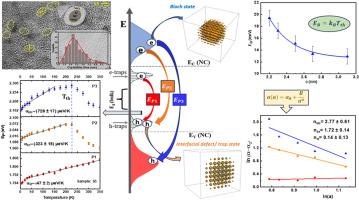纳米结构硅的温度依赖性光致发光:量子受限布洛赫态和界面缺陷的作用
IF 2.9
3区 物理与天体物理
Q3 NANOSCIENCE & NANOTECHNOLOGY
Physica E-low-dimensional Systems & Nanostructures
Pub Date : 2025-09-23
DOI:10.1016/j.physe.2025.116380
引用次数: 0
摘要
表面氧化纳米结构硅的强可见光致发光(PL)是由内部Bloch态和氧化相关界面缺陷的相互作用产生的,这使得它们的作用很难分离出来。在不同晶粒尺寸的纳米结构硅上的温度依赖(5−350K) PL测量显示出三种不同的衰变机制,包括带到带、带到陷阱和陷阱到陷阱的转变,到多个发射带出现在复杂的宽PL光谱中。在较低的温度< 225K时,与量子受限布洛赫态相关的PL峰值能量表现出近似线性的蓝移,这是由温度系数与有效晶粒尺寸之间强烈的逆幂律关系所控制的,而在较高的温度下,这一趋势正好相反。相反,缺陷相关的峰值能量在整个实验温度范围内以几乎恒定的速率单调增加。具有可分离伪势的有限系统的一般解析模型有效地估计了不同衰减通道对PL发射的贡献。理论结果与实验得到的幂律指数值吻合良好,为区分纳米结构硅中涉及量子受限布洛赫态和界面缺陷/陷阱态的辐射复合通道提供了一种新的方法。本文章由计算机程序翻译,如有差异,请以英文原文为准。

Temperature-dependent photoluminescence from nanostructured silicon: role of quantum-confined Bloch states and interfacial defects
The strong visible photoluminescence (PL) in surface-oxidized nanostructured silicon emerges from the interplay between intrinsic Bloch states and oxide-related interfacial defects, making it difficult to isolate their role. Temperature-dependent PL measurements on nanostructured silicon with varying crystallite sizes manifest three distinct decay mechanisms involving band-to-band, band-to-trap and trap-to-trap transitions to multiple emission bands appearing in the convoluted broad PL spectrum. At lower temperatures , PL peak energy associated with the quantum-confined Bloch states exhibits a nearly linear blue shift, governed by a strong inverse power law dependence of the temperature coefficient on the effective crystallite size, while this trend reverses at higher temperatures. Conversely, the defect-related peak energies increase monotonically at a nearly constant rate throughout the experimental temperature range. A general analytical model for finite systems with a separable pseudo-potential effectively estimates the contributions from different decay channels to the PL emission. Theoretical results align well with the experimentally obtained values of the power-law exponents, offering a novel way to distinguish between the radiative recombination channels involving quantum-confined Bloch states and interfacial defects/trap states in nanostructured silicon.
求助全文
通过发布文献求助,成功后即可免费获取论文全文。
去求助
来源期刊
CiteScore
7.30
自引率
6.10%
发文量
356
审稿时长
65 days
期刊介绍:
Physica E: Low-dimensional systems and nanostructures contains papers and invited review articles on the fundamental and applied aspects of physics in low-dimensional electron systems, in semiconductor heterostructures, oxide interfaces, quantum wells and superlattices, quantum wires and dots, novel quantum states of matter such as topological insulators, and Weyl semimetals.
Both theoretical and experimental contributions are invited. Topics suitable for publication in this journal include spin related phenomena, optical and transport properties, many-body effects, integer and fractional quantum Hall effects, quantum spin Hall effect, single electron effects and devices, Majorana fermions, and other novel phenomena.
Keywords:
• topological insulators/superconductors, majorana fermions, Wyel semimetals;
• quantum and neuromorphic computing/quantum information physics and devices based on low dimensional systems;
• layered superconductivity, low dimensional systems with superconducting proximity effect;
• 2D materials such as transition metal dichalcogenides;
• oxide heterostructures including ZnO, SrTiO3 etc;
• carbon nanostructures (graphene, carbon nanotubes, diamond NV center, etc.)
• quantum wells and superlattices;
• quantum Hall effect, quantum spin Hall effect, quantum anomalous Hall effect;
• optical- and phonons-related phenomena;
• magnetic-semiconductor structures;
• charge/spin-, magnon-, skyrmion-, Cooper pair- and majorana fermion- transport and tunneling;
• ultra-fast nonlinear optical phenomena;
• novel devices and applications (such as high performance sensor, solar cell, etc);
• novel growth and fabrication techniques for nanostructures

 求助内容:
求助内容: 应助结果提醒方式:
应助结果提醒方式:


